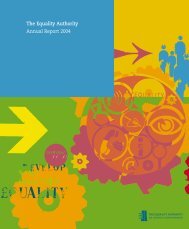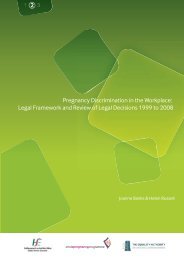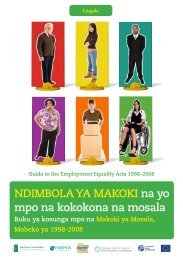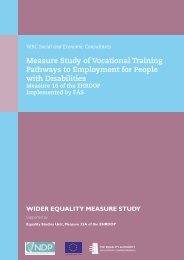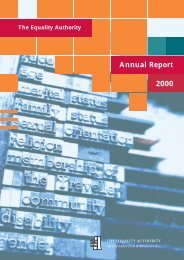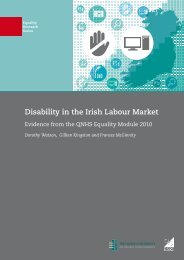Pregnancy and Employment: A Literature Review - Crisis Pregnancy ...
Pregnancy and Employment: A Literature Review - Crisis Pregnancy ...
Pregnancy and Employment: A Literature Review - Crisis Pregnancy ...
You also want an ePaper? Increase the reach of your titles
YUMPU automatically turns print PDFs into web optimized ePapers that Google loves.
<strong>Pregnancy</strong> <strong>and</strong> <strong>Employment</strong>: A <strong>Literature</strong> <strong>Review</strong><br />
number of pregnancy dismissal cases came from the private sector. Those with shorter job tenures made up a<br />
disproportionate number of claimants. In contrast, part-time workers were under-represented among claimants. It<br />
is argued that this may arise because full-timers are more likely to pursue legal action rather than because they are<br />
more vulnerable to discrimination (Banks & Russell, 2011).<br />
The Irish results are broadly similar to those found in other jurisdictions. Between 2003 <strong>and</strong> 2005 the Equal<br />
Opportunities Commission 8 (EOC) in the UK undertook a major research programme on pregnancy discrimination.<br />
As part of this programme, James (2004) investigated pregnancy-related unfair dismissal cases registered at<br />
employment tribunals in Engl<strong>and</strong> <strong>and</strong> Wales between 1996 <strong>and</strong> 2002 (378 cases). This study found that, as in<br />
Irel<strong>and</strong>, allegations of pregnancy-related discrimination were spread across the range of occupations where<br />
women were employed. The study also found a higher proportion of claims came from full-time employees. Over<br />
two-thirds of the dismissals occurred while at work during pregnancy i.e. before the commencement of maternity<br />
leave, suggesting that this is a particularly vulnerable period for women. The greater risk of pregnancy-related<br />
discrimination against women with less than one year’s service was also evident in the research (ibid, p32).<br />
As part of the EOC research programme on pregnancy discrimination, Gregory (2004) took a broader spectrum of<br />
pregnancy discrimination cases in the UK, which was not confined to dismissal cases. The data consisted of 258<br />
employment tribunal decisions heard between May 2002 <strong>and</strong> December 2003. Again, the over-representation of<br />
women with job tenures of less than one year <strong>and</strong> the under-representation of part-time workers was identified.<br />
The study found that less than 1% of cases involved women on non-permanent contracts, which does not reflect<br />
the incidence of temporary contracts in the workplace. The author suggests that this results not from a lower risk<br />
of pregnancy discrimination among this group, but rather “it is a reflection of the difficulties faced by pregnant<br />
women in attempting to argue that an employer’s failure to renew a temporary contract or make a contract<br />
permanent at the end of a probationary period was an act of discrimination”. Formal pregnancy-discrimination<br />
cases were almost entirely confined to the private sector <strong>and</strong> were more common among small employers. More<br />
than two-thirds of the employers had fewer than 50 employees, while only 19% of women in employment in<br />
the UK in the relevant age group were employed in such organisations (ibid). Less than 1% of the cases heard in<br />
the period involved public-sector employers. This result is attributed to the fact that the public sector has welldeveloped<br />
equal-opportunities policies <strong>and</strong> formal grievance procedures, <strong>and</strong> is more likely to attempt to settle<br />
cases before they reach a tribunal hearing.<br />
In Australia, the Human Rights <strong>and</strong> Equal Opportunity Commission (HREOC) undertook a National <strong>Pregnancy</strong><br />
<strong>and</strong> Work Inquiry (HREOC, 1999). Part of the study included an analysis of complaints of pregnancy discrimination<br />
received under the Sex Discrimination Act. Between 1984 <strong>and</strong> 1998, the annual proportion of sex-discrimination<br />
cases involving pregnancy discrimination ranged from 5% to 17%. The figure for the most recent year, 1997-98,<br />
was 10%. Further detail was provided on a small number of cases that were current in May 1999 (n=26). Of these,<br />
the majority concerned dismissal because of pregnancy (62%); 31% involved inappropriate or negative comments/<br />
questions about pregnancy; in 8% of cases, hours of work had allegedly been reduced due to pregnancy; 12%<br />
of complainants claimed they had been demoted because of pregnancy; 12% of cases involved inappropriate<br />
workloads/tasks, <strong>and</strong> one case (4%) involved less favourable assessment of work performance. 9<br />
Legal cases must, however, be seen as highly selective <strong>and</strong> cannot be taken to represent either the prevalence<br />
of pregnancy discrimination or the typical experience of women treated unfairly in the workplace. The survey<br />
carried out as part of the EOC’s research programme on pregnancy discrimination, discussed in the next section,<br />
found that less than 4% of women who had experienced discrimination during pregnancy took their case to an<br />
employment tribunal (Adams et al, 2005).<br />
2.3 Unfair Treatment: Findings of Equal Opportunities Commission<br />
<strong>Pregnancy</strong> Survey (UK)<br />
The EOC study adopted a broad view of pregnancy discrimination, taking it to mean “any disadvantage at work<br />
caused wholly or partly by pregnancy or by taking maternity leave” (EOC, 2005, pII). The main quantitative<br />
element of the research was a national survey of 1,006 women with a child aged between 9 <strong>and</strong> 12 months, who<br />
8 The Equal Opportunities Commission was later replaced by the Equality <strong>and</strong> Human Rights Commission.<br />
9 The percentages add up to more than 100% because some complaints involved more than one allegation.<br />
PAGE 13




